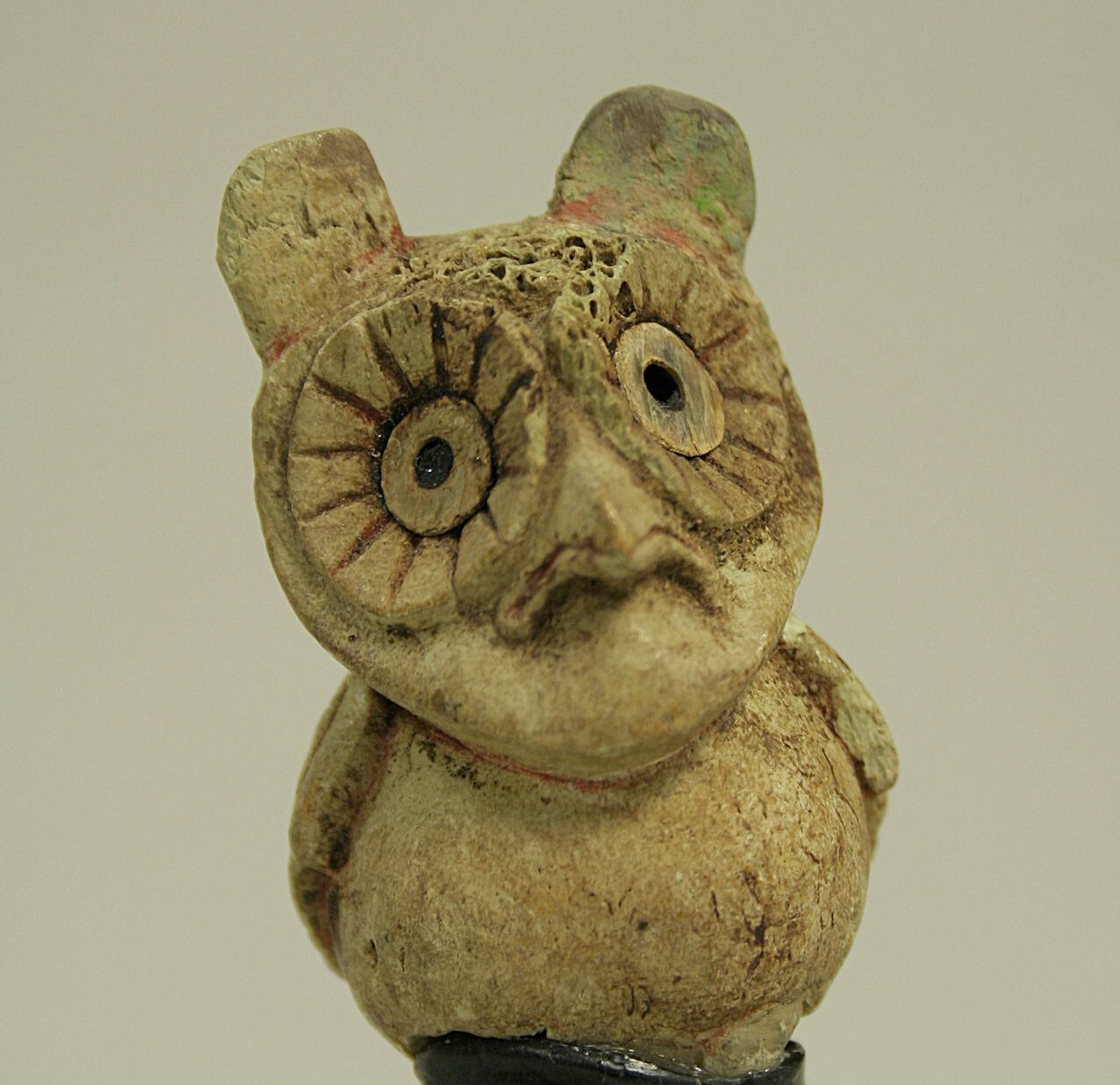Figure of an Owl
Not on view
Owls were a popular subject for Moche artists on Peru’s North Coast. They were depicted in metal (see for example Met accession numbers 1987.394.312, 1987.394.28, 1987.394.56, 1987.394.118, and 1979.206.1227), ceramics (66.30.5, 64.228.19, and 64.228.2), wood, and, as shown here, in bone. In this example, the carver has carefully indicated the owl’s “ear tufts” (not truly ears but rather the clumps of feathers seen on some owls) and the feathers forming a circle around the eyes. The zigzag pattern on the back also represents feathers, here highlighted by the red cinnabar rubbed into the incised lines.
The reason for the prominence of owls in Moche culture is unclear. It may reflect the fact that owls are nocturnal hunters capable of finding and seizing prey in what appears to us to be complete darkness. Some scholars have drawn a parallel between owls’ predatory behavior, particularly its propensity to decapitate its prey and drain the blood from the body, to human or supernatural ritual practices depicted on ceramics (see, for example, 1987.394.630; Bourget 1996).
This skillfully carved owl was probably originally designed to serve as a thumb rest on a throwing stick or atlatl. Spear throwers or atlatls, used in Europe, Asia, and the Americas, are simple but deadly weapons. When the dart or spear is engaged by a point or nub at the distal end of the stick, throwing the spear increases the velocity and distance via enhanced leverage. Throwing sticks are known in Europe from as early as 15,000 B.C. Many variations exist from simple sticks with articulating notches to more elaborate versions with a carved thumb hold, decorated shaft and modeled spear holder. The position of the thumb hold varies and can be on the same or opposite side of the articulation element. Peruvian craftsmen elaborated all of these elements of the atlatl to enhance their beauty. In addition to decorating the thumb hold or shaping the engagement knob, throwing sticks were also occasionally embellished with gold sheet. (For an example of depictions of warriors with spear throwers see Met accession number 1987.394.86.)
The Moche (also known as the Mochicas) flourished on Peru’s North Coast from 200-850 A.D., centuries before the rise of the Incas (Castillo, 2017). Over the course of some six centuries, the Moche built thriving regional centers from the Nepeña River Valley in the south to perhaps as far north as the Piura River, near the modern border with Ecuador, developing coastal deserts into rich farmlands and drawing upon the abundant maritime resources of the Pacific Ocean’s Humboldt Current. Although the Moche may never have formed a single centralized political entity, they shared unifying cultural traits such as religious practices (Donnan, 2010).
References and Additional Readings
Bourget, Steve. “Los raptores de almas: Prácticas funerarias en la iconografía Mochica." In Al Final del Camino, edited by Moisés Lemlij and Luis Millones. Lima: Seminario Interdisciplinario de Estudios Andinos, 1996.
Castillo, Luis Jaime. “Masters of the Universe: Moche Artists and Their Patrons.” In Golden Kingdoms: Luxury Arts in the Ancient Americas, edited by Joanne Pillsbury, Timothy Potts, and Kim N. Richter. Los Angeles: J. Paul Getty Museum, 2017, pp. 24-31.
Donnan, Christopher B. Moche Art of Peru. Pre-Columbian Symbolic Communication. Los Angeles: Museum of Cultural History, University of California, Los Angeles, 1978.
Donnan, Christopher B. “Moche State Religion.” In New Perspectives on Moche Political Organization, edited by Jeffrey Quilter and Luis Jaime Castillo. Washington D.C.: Dumbarton Oaks Research Library and Collection. 2010, pp. 47-69.
Donnan, Christopher B. and Donna McClelland. Moche Fineline Painting: Its Evolution and Its Artists. Los Angeles: Fowler Museum of Cultural History, University of California, Los Angeles, 1999.
Published
Donnan, Christopher B. Moche Art of Peru. Pre-Columbian Symbolic Communication. Los Angeles: Museum of Cultural History, University of California, Los Angeles, 1978, p. 23.
Sawyer, Alan Reed. The Nathan Cummings Collection of Ancient Peruvian Art (Formerly Wasserman-San Blas Collection). Chicago, 1954, p. 21.
Due to rights restrictions, this image cannot be enlarged, viewed at full screen, or downloaded.
This artwork is meant to be viewed from right to left. Scroll left to view more.




